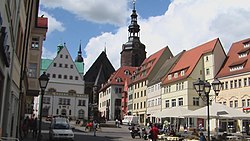Eisleben
Eisleben is a town in Saxony-Anhalt, Germany. It is famous as the hometown of Martin Luther; because of this, its official name is Lutherstadt Eisleben. In 2015, Eisleben had a population of 24,198.
Eisleben | |
|---|---|
 | |
| Coordinates: 51°31′N 11°33′E / 51.517°N 11.550°E | |
| Country | Germany |
| State | Saxony-Anhalt |
| District | Mansfeld-Südharz |
| Subdivisions | 6 |
| Government | |
| • Mayor | Jutta Fischer (SPD) |
| Area | |
| • Total | 143.81 km2 (55.53 sq mi) |
| Elevation | 114 m (374 ft) |
| Population (2021-12-31)[1] | |
| • Total | 22,404 |
| • Density | 160/km2 (400/sq mi) |
| Time zone | UTC+01:00 (CET) |
| • Summer (DST) | UTC+02:00 (CEST) |
| Postal codes | 06295 |
| Dialling codes | 03475, 034773, 034776 |
| Vehicle registration | MSH, EIL, HET, ML, SGH |
| Website | www |
| UNESCO World Heritage Site | |
|---|---|
| Part of | Luther Memorials in Eisleben and Wittenberg |
| Includes | |
| Criteria | Cultural: (iv)(vi) |
| Reference | 783 |
| Inscription | 1996 (20th Session) |
| Area | 0.20 ha (22,000 sq ft) |
| Buffer zone | 1.93 ha (208,000 sq ft) |
Eisleben has two parts old town and new town (Altstadt and Neustadt). The new town was created for Eisleben's miners in the 14th century.
Eisleben was the capital of the district of Mansfelder Land and is the seat of the Verwaltungsgemeinschaft ("collective municipality") Lutherstadt Eisleben.
History
changeEisleben was first written about in 997 as a market called Islebia, and in 1180 as a town. The counts of Mansfeld governed the area until the 18th century. In 1780, Eisleben came directly under the Electorate of Saxony. After the Napoleonic Wars, Eisleben became part of the Kingdom of Prussia. The Prussian Province of Saxony became part of the Free State of Prussia in the German Reich after World War I. After World War II, Eisleben became part of the new state of Saxony-Anhalt in the German Democratic Republic (GDR) until Germany's reuinification in 1990.
Helfta
changeIn 1229, the Counts of Mansfield started a convent for women. At first, it was on the grounds of their castle. Then they built a separate convent at Helfta near Eisleben, which opened in 1258. It was governed under either the Benedictine or Cistercian model. It became known for its powerful and mystical abbesses, including Gertrude of Hackeborn, Gertrude the Great and Mechtild. However, Duke Albrecht of Brunswick destroyed the convent in 1342. It was rebuilt the next year. It closed in 1524, but later reopened on a smaller scale until 1542
In 1542, it came under the control of local farmers. In 1712 it became a farm run by the Prussian state. In 1994, the Catholic Diocese of Magdeburg bought the property and began restoring the building. Cistercian nuns from Seligenthal in Bavaria moved in starting in approximately 1999.[2]
Martin Luther
changeThe Protestant reformer Martin Luther was born in Eisleben on November 10, 1483. His father, Hans Luther, was a miner. Luther's family moved to Mansfeld when he was only a year old; he lived in Wittenberg most of his life. Luther preached his last sermon and died in Eisleben in 1546.
Eisleben started preserving its Luther memorials in 1689.
In 1997, Eisleben's "Birth House" and "Death House" were added to the World Heritage List. Also, Luther was baptised in Eisleben's St. Peter and Paul Church. He preached his last sermons at St. Andreas Church.
Historical population
changeThe population has been declining since the mid-1960s due to declining birth rates and people moving away.[3] The municipal area has been enlarged several times by merging with neighboring districts.[4]
| Year | 1964 | 1971 | 1981 | 1989 | 1995 | 2000 | 2002 | 2004 | 2006 | 2008 |
| Inhabitants* | 44,773 | 41,682 | 37,330 | 35,374 | 31,882 | 29,526 | 28,848 | 28,040 | 27,037 | 26,190 |
| Year | 2010 | 2011 | 2012 | 2013 | 2014 | 2015 |
| Inhabitants* | 25,489 | 25,380 | 24,384 | 24,284 | 24,346 | 24,198 |
- * population as of 31st December, except for 1964–1981: census
People
change- Gertrude the Great (1256–1301), mystic, saint of the Catholic Church
- Martin Luther (1483–1546), Protestant reformer, author and professor of theology
- Johannes Agricola (1494–1566), Protestant reformer
- Michael Teuber (1524–1586), lawyer
- Caspar Schütz (around 1540-1594) German historian
- Friedrich Koenig (1774–1821), printer
- Ludwig Geyer (1779–1833), painter, playwright and actor
- Friedrich August von Quenstedt (1809–1889), geologist and paleontologist
- Carl Fischer (1841–1906), worker and author
- Max Schneider (1875–1967), music historian
- Hermann Lindrath (1896–1960), CDU politician and minister
- Egbert Hayessen (1913–1944), major and resistance fighter of 20 July 1944
- Ute Starke (born 1939), gymnast, Summer Olympics 1960, 1964 and 1968
- Gudrun Berend (1955-2011), hurdler
- Thomas Lange (born 1964), two-time Olympic champion in rowing
- Timo Hoffmann (born 1974), boxer
Twin town
change- Wycliffestead Lutterworth, United Kingdom, since 2015
References
change- ↑ "Bevölkerung der Gemeinden – Stand: 31. Dezember 2021" (PDF) (in German). Statistisches Landesamt Sachsen-Anhalt. June 2022.
- ↑ Witt, Claudia. "The History Of The Convent Of Helfta". Archived from the original on 2014-02-03. Retrieved 2017-10-03.
- ↑ Statistisches Landesamt Sachsen-Anhalt: Lutherstadt Eisleben – Landkreis Mansfeld-Südharz. Bevölkerungsstand (seit 1964) und Bevölkerungsbewegungen. Archived 2015-04-12 at the Wayback Machine Aktualisierung: 27. Juli 2016. In: statistik.sachsen-anhalt.de, abgerufen am 8. August 2016.
- ↑ StBA: Änderungen bei den Gemeinden Deutschlands, siehe 2007 Archived 2018-08-29 at the Wayback Machine (XLS; 369 kB; Datei ist nicht barrierefrei), abgerufen am 8. August 2016.



